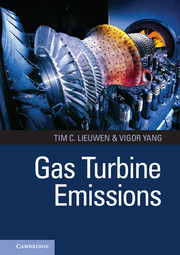Book contents
- Frontmatter
- Contents
- List of Contributors
- Foreword
- Preface
- Part 1 Overview and Key Issues
- 1 Aero Gas Turbine Combustion
- 2 Ground-Based Gas Turbine Combustion
- 3 Overview of Worldwide Aircraft Regulatory Framework
- 4 Overview of Worldwide Ground-Based Regulatory Framework
- Part 2 Fundamentals and Modeling: Production and Control
- Part 3 Case Studies and Specific Technologies: Pollutant Trends and Key Drivers
- Index
- References
4 - Overview of Worldwide Ground-Based Regulatory Framework
from Part 1 - Overview and Key Issues
Published online by Cambridge University Press: 05 June 2013
- Frontmatter
- Contents
- List of Contributors
- Foreword
- Preface
- Part 1 Overview and Key Issues
- 1 Aero Gas Turbine Combustion
- 2 Ground-Based Gas Turbine Combustion
- 3 Overview of Worldwide Aircraft Regulatory Framework
- 4 Overview of Worldwide Ground-Based Regulatory Framework
- Part 2 Fundamentals and Modeling: Production and Control
- Part 3 Case Studies and Specific Technologies: Pollutant Trends and Key Drivers
- Index
- References
Summary
Pollution prevention and energy conservation with system efficiency are key elements in arriving at cost-effective long-term solutions that address sustainability to implement national “clean energy” and energy security initiatives. Low air pollution, greenhouse gases, and water impacts are all important to local and regional areas and can be dealt with by some degree of regulatory oversight, with trade-offs appropriately evaluated. International emission standards and regulatory policies for gas turbines described here have developed over the past decade to address some of these challenges.
Gas turbine cogeneration and district energy plants with efficient cycles and reliable dry low NOx combustion can provide important environmental improvements to cleaner energy production. Until recently, GHG emissions and system energy efficiency have not been closely studied in most permitting processes. Pollution prevention planning and environmental assessments may require a more comprehensive strategy, with balanced economic and environmental implementation to allow consideration of a wide range of renewable and cleaner energy choices, including various gas-turbine-based applications.
- Type
- Chapter
- Information
- Gas Turbine Emissions , pp. 95 - 120Publisher: Cambridge University PressPrint publication year: 2013



